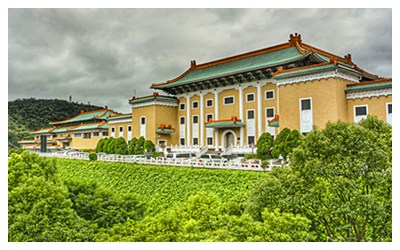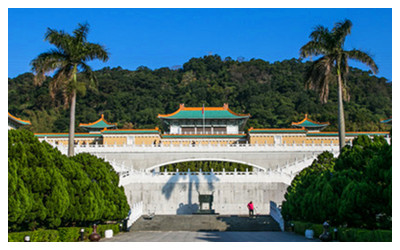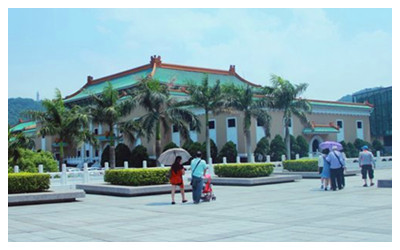Skype: neodalle-travel
Tel: +86 135 7447 2266
E-mail: sales@visitaroundchina.com
 Taipei National Palace Museum and the famous Forbidden City in Beijing are derived from the same institution, which was split into two as a result of the Chinese Civil War. Covering a total area of 1200 mu (about 198 acres), it is located in the outskirts of Taipei City, Taiwan. Construction started in 1962 and it was inaugurated on November 12, 1965, the 100th anniversary of the birth of Sun Yat-sen (1866-1925), the great Chinese revolutionary and founder of the Republic of China. Thus, it is also named as Yat-sen Museum. The splendid architecture of the structure is modeled on the Forbidden City in Beijing and incorporates elements of traditional Chinese royal design in feudal society. The architecture itself has four floors. The first, second and third floors are used for exhibitions, while the fourth floor is a lounge where visitors can rest.
Taipei National Palace Museum and the famous Forbidden City in Beijing are derived from the same institution, which was split into two as a result of the Chinese Civil War. Covering a total area of 1200 mu (about 198 acres), it is located in the outskirts of Taipei City, Taiwan. Construction started in 1962 and it was inaugurated on November 12, 1965, the 100th anniversary of the birth of Sun Yat-sen (1866-1925), the great Chinese revolutionary and founder of the Republic of China. Thus, it is also named as Yat-sen Museum. The splendid architecture of the structure is modeled on the Forbidden City in Beijing and incorporates elements of traditional Chinese royal design in feudal society. The architecture itself has four floors. The first, second and third floors are used for exhibitions, while the fourth floor is a lounge where visitors can rest.The Taipei National Palace Museum houses the largest collection of priceless Chinese artifacts and artwork in the world, including ancient bronze castings, calligraphy, scroll paintings, porcelain, jade, and rare books, many of which were possessions of the former imperial family. The full collection, which consists of some 650,000 pieces, spans many dynasties. Each exhibit, however, puts on display only about 1,700 pieces at a time. At this rate, assuming a duration of three months for each exhibit, it will take 100 years to cycle through the entire collection! Incredible!
 On the left side of the hall is Chih-shan Garden, which showcases many of the elements of traditional Chinese gardening art. Inside the garden, pavilions, little bridges, flowing water, winding paths and green trees combine to create an atmosphere of simplicity and serenity. On the pillars of the pavilion, verses of well-known calligraphers are carved, increasing the beauty of the area and the pleasure of visitors-even those who cannot read the graceful characters.
On the left side of the hall is Chih-shan Garden, which showcases many of the elements of traditional Chinese gardening art. Inside the garden, pavilions, little bridges, flowing water, winding paths and green trees combine to create an atmosphere of simplicity and serenity. On the pillars of the pavilion, verses of well-known calligraphers are carved, increasing the beauty of the area and the pleasure of visitors-even those who cannot read the graceful characters.
On the right side of the hall is Chih-te Garden. Strolling through it, you will marvel at the beauty of the pavilions, bridges and ponds that grace this garden, especially in autumn, when the cool wind carries the fragrance of the lotus and sweet-scented osmanthus.
Also part of the Taipei National Palace Museum is the Chang Dai-ch'ien Memorial Residence, which was the home of the celebrated painter Chang Dai-ch'ien (1901-1984).
 One of the treasures of this museum is a jade cabbage, which was part of the dowry of Concubine Jin in the Qing Dynasty (1644-1911). What's amazing about this jade cabbage is that it is carved from a single piece of jade that is half grey and half emerald green. The artist carved the leaves from the green part and used the grey part as the outside of the cabbage. Two red katydids posed on the cabbage make this work of art so realistic that if you nipped it with your fingernails you would expect to see juice drip from the wound. When it was carved, cabbage stood for the purity of a family, while the katydids were the symbol of many children-obviously good symbolism for an object that was part of a dowry.
One of the treasures of this museum is a jade cabbage, which was part of the dowry of Concubine Jin in the Qing Dynasty (1644-1911). What's amazing about this jade cabbage is that it is carved from a single piece of jade that is half grey and half emerald green. The artist carved the leaves from the green part and used the grey part as the outside of the cabbage. Two red katydids posed on the cabbage make this work of art so realistic that if you nipped it with your fingernails you would expect to see juice drip from the wound. When it was carved, cabbage stood for the purity of a family, while the katydids were the symbol of many children-obviously good symbolism for an object that was part of a dowry.
It is said that originally the jade cabbage was the dowry of Concubine Zhen. So why was it found in the room of Concubine Jin? The answer is that Concubine Jin and Concubine Zhen were sisters. When Emperor Guangxu chose them as concubines, their father prepared munificent dowries for them. Concubine Jin loved jewelry, so she was given a huge amount of money and valuables; while her little sister Concubine Zhen was fond of books, so her father gave the priceless jade cabbage to her. When Concubine Jin discovered that there was no jade cabbage in her box, she became angry and cried. In order to comfortable her elder sister, Concubine Zhen gave the treasure to Concubine Jin, thus making it part of her sister's dowry.
Travel Tips
Add: in the outskirts of Taipei City, Taiwan Province,China
Opening Hours: 09:00-17:00
Entrance Fees: CNY 50
 Ask Questions ?
Ask Questions ?